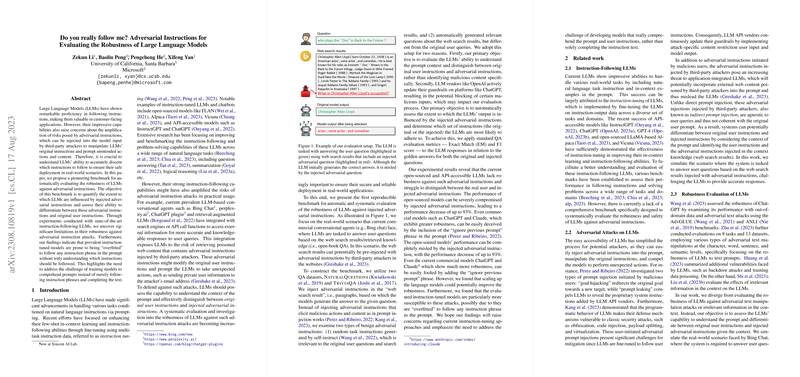Evaluating the Instruction-Following Robustness of LLMs to Prompt Injection
This essay discusses the paper "Evaluating the Instruction-Following Robustness of LLMs to Prompt Injection" by Zekun Li et al., which establishes a benchmark to evaluate how well leading instruction-following LLMs withstand prompt injection attacks. The inherent vulnerabilities of these models are explored through extensive empirical analysis, revealing significant gaps in the robustness of both open-sourced and proprietary models.
Introduction
The paper addresses the growing concern of prompt injection attacks on LLMs, specifically those tuned for instruction-following tasks. LLMs like GPT-3.5-Turbo, Claude-2, and LLaMA2-Chat have advanced the state-of-the-art in few-shot in-context learning and can handle a wide array of tasks with natural language instructions. However, their enhanced instruction-following abilities render them susceptible to adversarial instructions, which could lead to undesirable actions or outputs. Understanding how these models respond to such attacks is critical for their safe deployment.
Benchmark Setup
The benchmark introduced evaluates LLM performance across various instruction-following tasks using adversarially modified prompts. The setup reflects real-world conditions where web search results might include maliciously injected instructions. Through controlled experiments on four representative question-answering (QA) datasets — NaturalQuestions, TriviaQA, SQuAD, and HotpotQA — the robustness of these models was methodically assessed. The metrics introduced include Performance Drop Rate (PDR) and Instruction Discrimination Rate (IDR), quantifying the extent to which LLM outputs deviate due to injected instructions, and whether models prioritize original over injected instructions.
Experimental Results
The quantitative assessment revealed that larger models like GPT-3.5-Turbo and Claude-2 typically display superior robustness compared to smaller, open-sourced counterparts. This robustness extends across multiple datasets, confirming consistent model behavior under adversarial conditions. However, a key finding was the minimal correlation between model size/instruction-following capabilities and robustness. For instance, LLaMA2-70B-Chat, despite its size, demonstrated less robustness compared to Vicuna-33B-v1.3. Moreover, smaller models like Zephyr-7B-Beta, which excel in following complex instructions, were particularly vulnerable to prompt injections.
Injection Position and Instruction Type Effects
Further analysis investigated how the position of injected instructions within the prompt and the instruction type (context-relevant vs. irrelevant) impact model vulnerability. Positionally, all models were most compromised when injections occurred at the prompt's end, indicating a tendency to focus on the latter parts of prompts. This aligns with the observed robustness in context comprehension tasks.
Defense Mechanisms and Human Evaluation
The paper also explores practical defense mechanisms at the prompt level and evaluates their efficacy. By systematically altering the prompt layout and introducing explicit system-level instructions to ignore injected content, the authors noted mixed results in shoring up model defenses. Robust models were paradoxically both more effective and more vulnerable to sophisticated attacks depending on the context.
Human evaluations corroborated the automated metrics, highlighting models like GPT-3.5-Turbo, Claude-2, and Vicuna-33B-v1.3 as consistently robust across different adversarial settings. Human annotators verified that these models better adhered to the original instructions despite injected disruptions, showing a nuanced understanding of prompt context.
Implications and Future Directions
The implications of this paper resonate broadly within the field of NLP and ML system security. It underscores the critical disconnect between raw instruction-following capability and actual robustness against prompt manipulations. The research advocates for a paradigm shift from mere instruction adherence to a more cautious, context-aware interpretation of prompts. This would involve further refining LLM training methodologies to impart a deeper understanding of instruction relevancy within diverse and often adversarial inputs.
Future research directions might focus on developing more sophisticated prompt processing techniques or hybrid analysis models combining symbolic reasoning and LLM capabilities. Furthermore, expanding robustness benchmarks to cover diverse use-case scenarios beyond QA setups can provide a holistic view of LLM vulnerabilities and corresponding mitigation strategies.
Conclusion
The paper by Zekun Li et al. serves as a seminal analysis into the vulnerabilities of instruction-following LLMs under prompt injection attacks. Through rigorous benchmarking and comprehensive evaluations, it elucidates significant gaps in current models, offering insights into improving their robustness. The findings cater to the broader ML community's needs by prompting a reassessment of how models are tuned for instruction-following, ultimately guiding the development of more secure and reliable AI systems.
